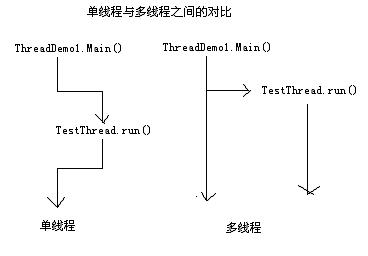一个进程中又可以包含一个或多个线程,一个线程就是一个程序内部的一条执行线索,如果要一程序中实现多段代码同时交替运行,就需产生多个线程,并指定每个线程上所要运行的代码段,这就是多线程。

public void run()
Runnable 运行对象构造的,则调用该 Runnable 对象的 run 方法;否则,该方法不执行任何操作并返回。
Thread 的子类应该重写该方法。Runnable 的对象创建一个线程时,启动该线程将导致在独立执行的线程中调用对象的 run 方法。
run 的常规协定是,它可能执行任何所需的操作。在java中要想实现多线程,有两种手段,一种是继续Thread类,另外一种是实现Runable接口。
对于直接继承Thread的类来说,代码大致框架是:
class 类名 extends Thread{
方法1;
方法2;
…
public void run(){
// other code…
}
属性1;
属性2;
…
}例子:
/**
* @author Rollen-Holt 继承Thread类,直接调用run方法
* */
class hello extends Thread {
public hello() {
}
public hello(String name) {
this.name = name;
}
public void run() {
for (int i = 0; i < 5; i++) {
System.out.println(name + "运行 " + i);
}
}
public static void main(String[] args) {
hello h1=new hello("A");
hello h2=new hello("B");
h1.run();
h2.run();
}
private String name;
}
【运行结果】:
A运行 0
A运行 1
A运行 2
A运行 3
A运行 4
B运行 0
B运行 1
B运行 2
B运行 3
B运行 4
我们会发现这些都是顺序执行的,说明我们的调用方法不对,应该调用的是start()方法。
当我们把上面的主函数修改为如下所示的时候:
<span style="font-size:14px;">public static void main(String[] args) {
hello h1=new hello("A");
hello h2=new hello("B");
h1.start();
h2.start();
}</span>然后运行程序,输出的可能的结果如下:
A运行 0
B运行 0
B运行 1
B运行 2
B运行 3
B运行 4
A运行 1
A运行 2
A运行 3
A运行 4
因为需要用到CPU的资源,所以每次的运行结果基本是都不一样的,呵呵。
注意:虽然我们在这里调用的是start()方法,但是实际上调用的还是run()方法的主体。
那么:为什么我们不能直接调用run()方法呢?
我的理解是:线程的运行需要本地操作系统的支持。
如果你查看start的源代码的时候,会发现:
public synchronized void start() {
/**
* This method is not invoked for the main method thread or "system"
* group threads created/set up by the VM. Any new functionality added
* to this method in the future may have to also be added to the VM.
*
* A zero status value corresponds to state "NEW".
*/
if (threadStatus != 0 || this != me)
throw new IllegalThreadStateException();
group.add(this);
start0();
if (stopBeforeStart) {
stop0(throwableFromStop);
}
}
private native void start0();
注意我用红色加粗的那一条语句,说明此处调用的是start0()。并且这个这个方法用了native关键字,次关键字表示调用本地操作系统的函数。因为多线程的实现需要本地操作系统的支持。
但是start方法重复调用的话,会出现java.lang.IllegalThreadStateException异常。
通过实现Runnable接口:
class 类名 implements Runnable{
方法1;
方法2;
…
public void run(){
// other code…
}
属性1;
属性2;
…
}
/**
* @author Rollen-Holt 实现Runnable接口
* */
class hello implements Runnable {
public hello() {
}
public hello(String name) {
this.name = name;
}
public void run() {
for (int i = 0; i < 5; i++) {
System.out.println(name + "运行 " + i);
}
}
public static void main(String[] args) {
hello h1=new hello("线程A");
Thread demo= new Thread(h1);
hello h2=new hello("线程B");
Thread demo1=new Thread(h2);
demo.start();
demo1.start();
}
private String name;
}【可能的运行结果】:
线程A运行 0
线程B运行 0
线程B运行 1
线程B运行 2
线程B运行 3
线程B运行 4
线程A运行 1
线程A运行 2
线程A运行 3
线程A运行 4
关于选择继承Thread还是实现Runnable接口?
其实Thread也是实现Runnable接口的:
class Thread implements Runnable {
//…
public void run() {
if (target != null) {
target.run();
}
}
}其实Thread中的run方法调用的是Runnable接口的run方法。不知道大家发现没有,Thread和Runnable都实现了run方法,这种操作模式其实就是代理模式。关于代理模式,我曾经写过一个小例子呵呵,大家有兴趣的话可以看一下:http://www.cnblogs.com/rollenholt/archive/2011/08/18/2144847.html
Thread和Runnable的区别:
如果一个类继承Thread,则不适合资源共享。但是如果实现了Runable接口的话,则很容易的实现资源共享。
/**
* @author Rollen-Holt 继承Thread类,不能资源共享
* */
class hello extends Thread {
public void run() {
for (int i = 0; i < 7; i++) {
if (count > 0) {
System.out.println("count= " + count--);
}
}
}
public static void main(String[] args) {
hello h1 = new hello();
hello h2 = new hello();
hello h3 = new hello();
h1.start();
h2.start();
h3.start();
}
private int count = 5;
}【运行结果】:
count= 5
count= 4
count= 3
count= 2
count= 1
count= 5
count= 4
count= 3
count= 2
count= 1
count= 5
count= 4
count= 3
count= 2
count= 1
大家可以想象,如果这个是一个买票系统的话,如果count表示的是车票的数量的话,说明并没有实现资源的共享。
我们换为Runnable接口:
/**
* @author Rollen-Holt 继承Thread类,不能资源共享
* */
class hello implements Runnable {
public void run() {
for (int i = 0; i < 7; i++) {
if (count > 0) {
System.out.println("count= " + count--);
}
}
}
public static void main(String[] args) {
hello he=new hello();
new Thread(he).start();
}
private int count = 5;
}【运行结果】:
count= 5
count= 4
count= 3
count= 2
count= 1
总结一下吧:
实现Runnable接口比继承Thread类所具有的优势:
1):适合多个相同的程序代码的线程去处理同一个资源
2):可以避免java中的单继承的限制
3):增加程序的健壮性,代码可以被多个线程共享,代码和数据独立。
/**
* @author Rollen-Holt
* 取得线程的名称
* */
class hello implements Runnable {
public void run() {
for (int i = 0; i < 3; i++) {
System.out.println(Thread.currentThread().getName());
}
}
public static void main(String[] args) {
hello he = new hello();
new Thread(he,"A").start();
new Thread(he,"B").start();
new Thread(he).start();
}
}【运行结果】:
A
A
A
B
B
B
Thread-0
Thread-0
Thread-0
说明如果我们没有指定名字的话,系统自动提供名字。
提醒一下大家:main方法其实也是一个线程。在java中所以的线程都是同时启动的,至于什么时候,哪个先执行,完全看谁先得到CPU的资源。
在java中,每次程序运行至少启动2个线程。一个是main线程,一个是垃圾收集线程。因为每当使用java命令执行一个类的时候,实际上都会启动一个JVM,每一个jVM实习在就是在操作系统中启动了一个进程。
判断线程是否启动
/**
* @author Rollen-Holt 判断线程是否启动
* */
class hello implements Runnable {
public void run() {
for (int i = 0; i < 3; i++) {
System.out.println(Thread.currentThread().getName());
}
}
public static void main(String[] args) {
hello he = new hello();
Thread demo = new Thread(he);
System.out.println("线程启动之前---》" + demo.isAlive());
demo.start();
System.out.println("线程启动之后---》" + demo.isAlive());
}
}【运行结果】
线程启动之前---》false
线程启动之后---》true
Thread-0
Thread-0
Thread-0
主线程也有可能在子线程结束之前结束。并且子线程不受影响,不会因为主线程的结束而结束。
版权声明:本文为博主原创文章,未经博主允许不得转载。
原文地址:http://blog.csdn.net/u014082714/article/details/48057941